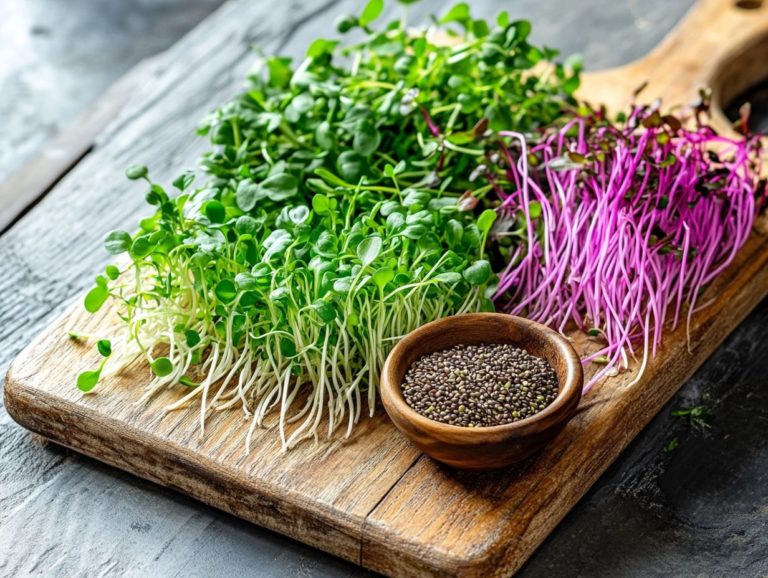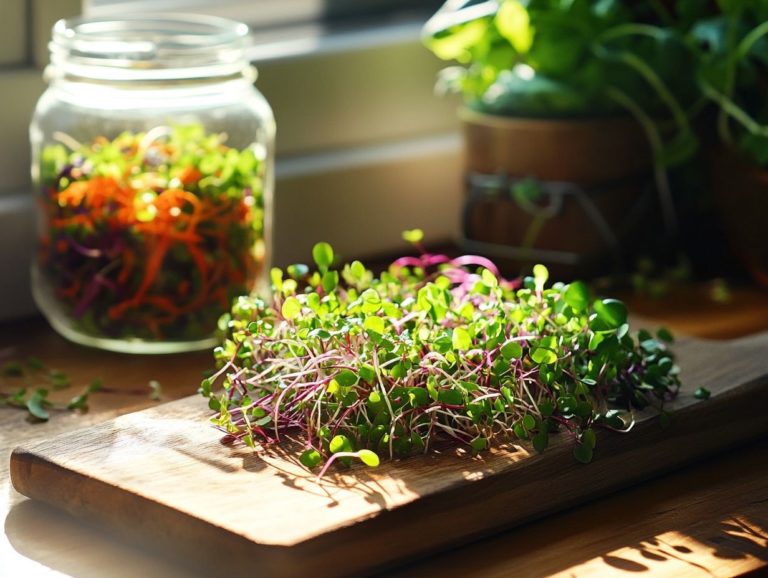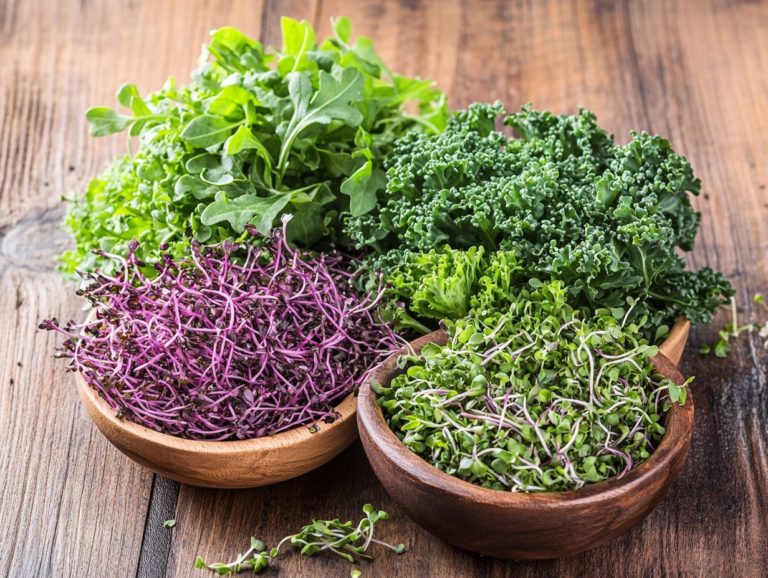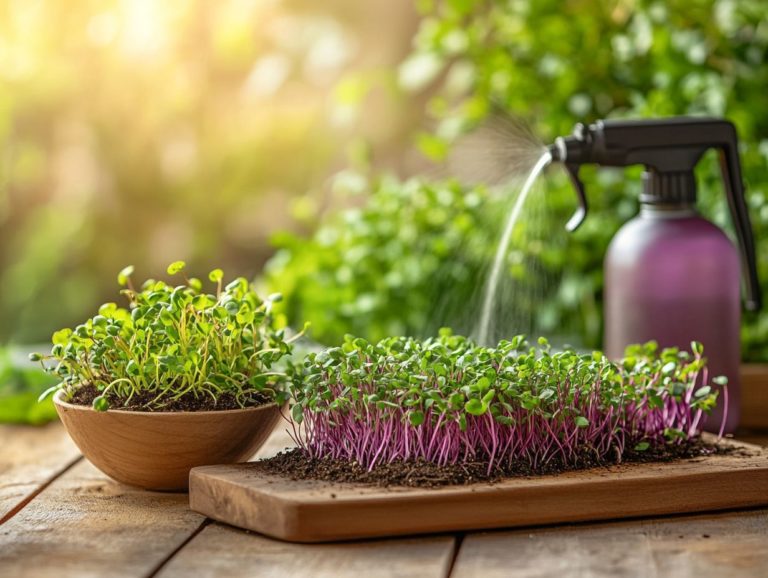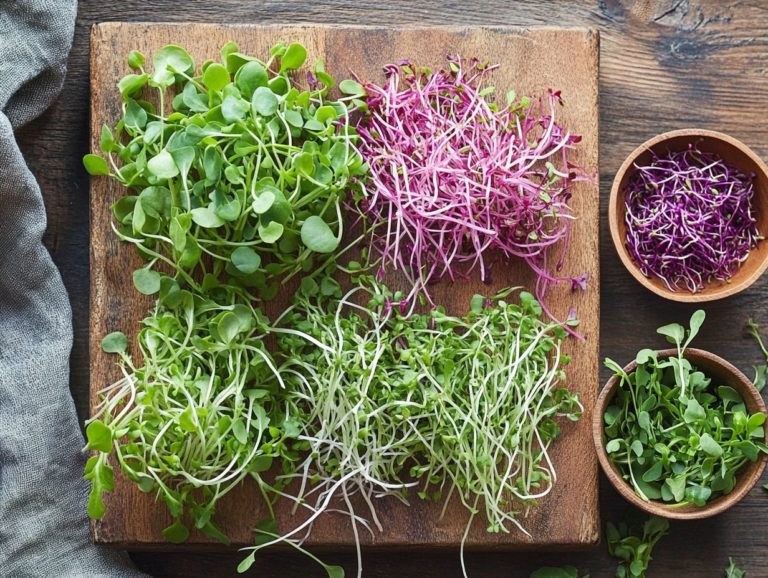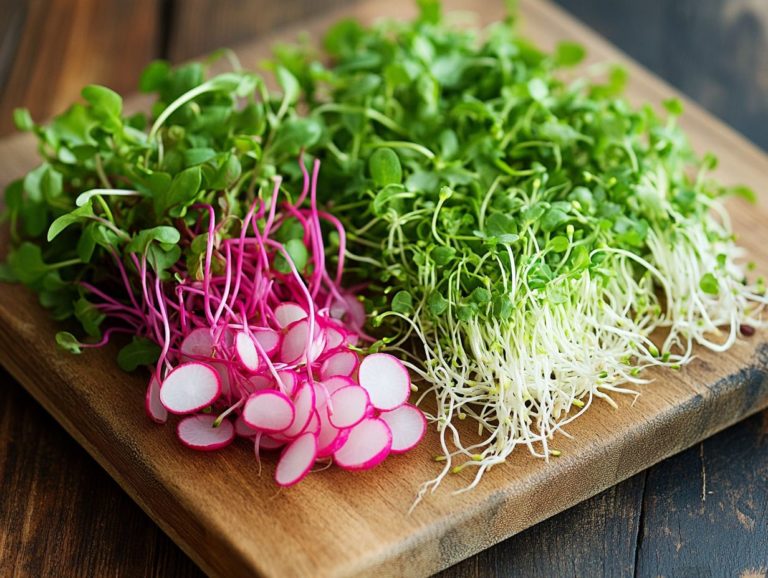5 Microgreens That Help Lower Blood Pressure
Looking to naturally lower your blood pressure? Microgreens could very well be your answer!
These tiny greens think arugula, broccoli, kale, red cabbage, and spinach are packed with nutrients and offer many health benefits. You ll discover how these vibrant microgreens can positively impact your cardiovascular health, the essential nutrients they provide, and some creative ways to incorporate them into your meals.
Important precautions to consider include other foods that can support your heart health. Jump in to discover the amazing benefits of microgreens today!
Contents
- Key Takeaways:
- 1. Arugula
- 2. Broccoli
- 3. Kale
- 4. Red Cabbage
- 5. Spinach
- How Do Microgreens Help Lower Blood Pressure?
- Frequently Asked Questions
- What are microgreens and how do they help lower blood pressure?
- Which microgreens are known for their blood pressure-lowering properties?
- How much of these microgreens should I consume to see a difference in my blood pressure?
- Can microgreens be used as a supplement for blood pressure medication?
- Are there any other health benefits of consuming these microgreens?
- Are there any possible side effects of consuming these microgreens?
Key Takeaways:

- Eating microgreens like arugula, broccoli, kale, red cabbage, and spinach can help lower blood pressure.
- These microgreens are rich in nutrients like potassium, magnesium, and nitrates that help relax blood vessels.
- Incorporating microgreens into salads, smoothies, or as garnishes can enhance your meals and health!
1. Arugula
Arugula, a member of the Brassicaceae family, is a microgreen that deserves a prominent place in your health-conscious diet. This highly nutritious leafy green is packed with antioxidants and many health benefits.
Rich in rich nutrients, arugula shines with its high vitamin K content, essential for bone health and proper clotting. Its impressive vitamin A levels support both vision and immune function.
It also offers a solid dose of dietary fiber, promoting digestive health.
With its peppery, slightly bitter flavor, arugula can elevate a range of dishes whether it’s a fresh salad, a hearty sandwich, or even as a unique topping for pasta and pizza.
Its versatility is remarkable; you can toss arugula into fresh salads, blend it into smoothies, or use it as a vibrant garnish. This means you can easily incorporate its robust taste and impressive health benefits into your everyday meals.
2. Broccoli
Broccoli microgreens aren’t just bursting with flavor; they re also a powerhouse of rich nutrients, including vitamin C and phytonutrients, which are natural compounds found in plants that have health benefits.
These tiny greens shine brightly due to their remarkable ability to combat oxidative stress. Their potent antioxidants work tirelessly to neutralize harmful free radicals in your body. Plus, they play a crucial role in promoting gut health by supporting the growth of beneficial bacteria and aiding digestion.
Growing these nutrient-rich microgreens is a breeze. You can cultivate them indoors or outdoors, requiring only minimal space and a few simple daily care steps. In terms of preparation, toss them into salads, sandwiches, or smoothies, and watch how they elevate both flavor and your overall health.
3. Kale
Kale microgreens are your go-to nutrient powerhouses, offering a robust source of vitamin K, iron, and dietary fiber your allies in enhancing health and preventing disease.
These petite greens deliver an impressive nutritional boost, particularly in warding off iron deficiency, which is essential for maintaining your energy levels and overall vitality. They re not just a pretty garnish; their heart-healthy benefits are noteworthy as well.
With their antioxidants, they help combat inflammation and enhance cholesterol levels. Whether you toss them into salads, blend them into smoothies, or use them as a garnish, you re not just elevating the flavor but also supercharging your meals with added nutrition.
If you’re keen on gardening, kale microgreens are easy to grow in small spaces. Requiring minimal effort and just the right amount of light, they are the perfect choice for home gardeners eager to enjoy fresh produce right at their fingertips.
4. Red Cabbage
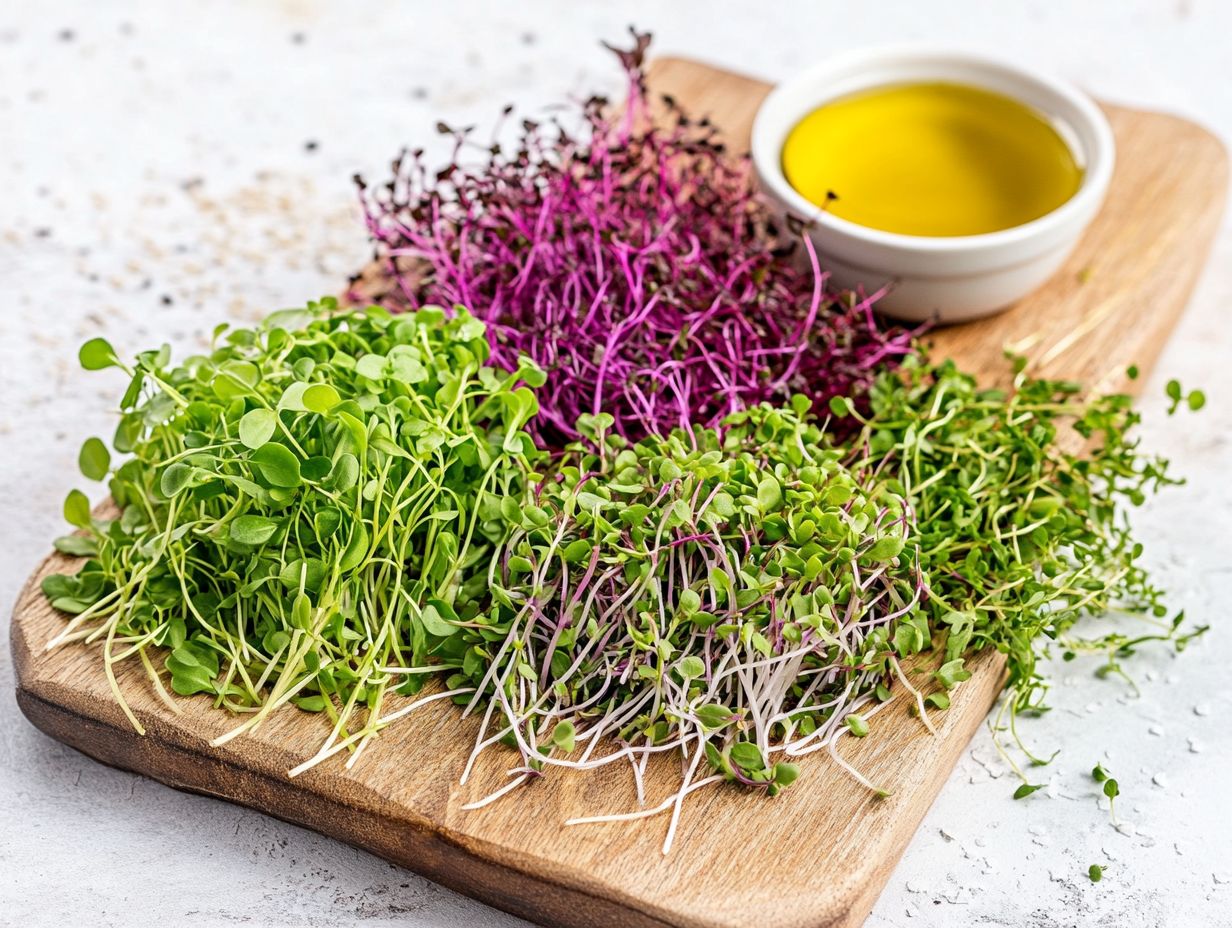
Red cabbage microgreens are not just a feast for the eyes; they’re a powerhouse of nutrients, brimming with antioxidants and plant compounds that can help protect our bodies from disease that play a crucial role in disease prevention and heart health.
These tiny greens shine particularly bright when it comes to supporting cardiovascular health. They help reduce inflammation and enhance circulation. The compounds nestled within red cabbage microgreens work wonders, effectively lowering blood pressure and preventing plaque buildup in your arteries. For a delicious boost, consider adding the top 5 microgreens for smoothies to your diet.
Add these vibrant greens to your diet for an explosion of flavor and nutrients! They make a fantastic addition to salads, sandwiches, or even smoothies. Just a handful sprinkled over a savory omelet or mixed into a refreshing slaw can elevate your meals while delivering essential antioxidants that bolster your overall well-being.
5. Spinach
Spinach microgreens are packed with vitamin E and essential minerals that contribute significantly to your overall well-being.
These tiny greens come packed with impressive vitamins A, C, and K, along with crucial minerals like magnesium, potassium, and calcium. Together, these nutrients work wonders for your gut health by fostering a balanced microbiome and aiding digestion.
With their low glycemic index, spinach microgreens help stabilize blood sugar levels. This makes them an ideal choice if you re keeping an eye on your glucose.
Incorporating them into your daily meals is a breeze. Sprinkle them fresh on salads, blend them into smoothies for an extra nutritional punch, or use them as a vibrant garnish for soups and sandwiches. Their mild flavor beautifully complements a variety of dishes while delivering a wealth of health benefits.
How Do Microgreens Help Lower Blood Pressure?
Microgreens, like arugula and kale, can be your allies in lowering blood pressure. Their impressive levels of antioxidants, dietary fiber, and concentrated nutrients, including vitamin K and beta carotene, support heart health.
Research highlights that these petite greens are rich in compounds such as glucosinolates, which help detoxify the body, and nitrates, which improve blood flow. Additionally, these greens may contribute to your well-being; for instance, how microgreens can reduce stress levels is an important aspect to consider. These compounds are essential for promoting blood vessel dilation and enhancing circulation.
Regularly consuming small greens not only amplifies your overall nutrition but offers a delicious way to combat hypertension. Nutritionists recommend exploring 5 nutritious microgreen varieties for smoothies for maximum health benefits while keeping your meals vibrant and exciting.
What Are the Nutrients Found in These Microgreens?
Microgreens are a treasure trove of essential nutrients, packed with vitamins A and K, and vitamin E, alongside a rich array of phytonutrients that play pivotal roles in promoting health and preventing disease.
These tiny powerhouses aren’t just vibrant and flavorful additions to your meals; they also come with impressive antioxidant properties that help combat oxidative stress in your body. Antioxidants like flavonoids and carotenoids found in various microgreens, including 5 microgreens for enhancing eye health, are linked to reduced inflammation and improved heart health.
The dietary fiber in microgreens aids digestion, contributing to a satisfying feeling of fullness that can be beneficial for weight management.
Incorporating these nutrient-dense greens into your diet is a savvy strategy for enhancing your overall nutritional intake and supporting your well-being.
What Are the Other Health Benefits of These Microgreens?

Along with their impressive nutrient profile, microgreens provide a myriad of health benefits, including potential cancer prevention and enhancements in gut health, making them a valuable addition to your diet.
These tiny powerhouses are also being studied for their ability to reduce insulin resistance, which plays a crucial role in managing blood sugar levels. Research suggests that certain varieties of microgreens, like broccoli and red cabbage, stand out due to their high levels of sulforaphane, a compound that may help improve insulin sensitivity. For a delicious way to incorporate these benefits into your diet, consider the top 5 microgreen varieties for breakfast.
Many people who add microgreens to their meals often report feeling more energetic and having better control over their cravings. These personal stories are supported by studies indicating that including nutrient-dense foods like microgreens can enhance overall wellness and may aid in chronic disease prevention, including benefits for heart health as outlined in how microgreens improve cardiovascular health.
How Can One Incorporate These Microgreens into Their Diet?
Incorporating microgreens into your meals is easy and rewarding, enhancing their nutritional value with vibrant flavors and concentrated nutrients.
By adding these tiny, nutrient-packed greens to your dishes, you can elevate both taste and presentation. For instance, tossing a handful of microgreens into a fresh salad instantly brightens the look while boosting health benefits.
In your morning smoothies, blending them in adds an extra kick of flavor and nutrition, easily fitting into your breakfast routine. Using microgreens as garnishes on soups or main courses can transform a simple dish into a gourmet experience, allowing their unique flavors to shine.
Exploring different preparations reveals how beautifully microgreens complement a variety of cuisines. Transform your meals into a culinary delight!
Are There Any Precautions or Side Effects to Consider?
While microgreens are generally safe and nutritious, it’s essential to keep a few precautions in mind, particularly around food safety and proper growing practices.
Contamination is a significant concern when cultivating or consuming these vibrant young plants. Without proper handling, they can harbor pathogens like E. coli or Salmonella. Some people may be allergic to certain microgreens, so it’s important to be aware of personal sensitivities. Additionally, incorporating microgreens that support healthy aging can enhance your diet while being mindful of safety.
To enjoy microgreens safely, remember to wash them thoroughly. This simple step can help protect your health! Ensure that your microgreens are grown in a clean environment using sterilized soil and seeds, while maintaining excellent hygiene during harvesting and preparation.
What Other Foods Can Help Lower Blood Pressure?
Along with microgreens, many foods can help lower blood pressure, including legumes, healthy fats, and vegetables rich in potassium and antioxidants.
Incorporating beans, such as black or kidney beans, into your meals not only provides a great source of fiber but also essential nutrients that help maintain healthy blood pressure levels. Avocados, with their creamy texture, are loaded with monounsaturated fats and potassium, making them a delicious addition to salads or smoothies. Additionally, consider adding microgreens to boost energy levels for an extra nutritional kick.
Leafy greens, like spinach and kale, are full of antioxidants and essential minerals that effectively combat hypertension. Combining these with a diverse diet that includes microgreens known for their concentrated nutrients creates a powerful support system for optimal heart health.
By prioritizing these dietary choices, you can make significant progress in naturally regulating your blood pressure.
Frequently Asked Questions

What are microgreens and how do they help lower blood pressure?
Packed with nutrients, these tiny powerhouses can boost your health! Microgreens are young, edible plants harvested after just a few weeks of growth. They contain compounds that can help regulate blood pressure and reduce the risk of heart problems.
Which microgreens are known for their blood pressure-lowering properties?
Some top microgreens for lowering blood pressure include broccoli, cabbage, cilantro, radish, and sunflower shoots. These greens are rich in antioxidants, which are substances that help protect your cells, and minerals that promote healthy blood flow and support heart health.
How much of these microgreens should I consume to see a difference in my blood pressure?
To see a noticeable change in your blood pressure levels, aim for about 1-2 ounces of these microgreens daily. You can easily add them to salads, sandwiches, smoothies, or use them as a garnish on various dishes. Start adding these microgreens to your diet today to experience remarkable health benefits!
Can microgreens be used as a supplement for blood pressure medication?
No, microgreens should not replace blood pressure medication prescribed by your doctor. However, they can be a beneficial addition to a healthy diet and lifestyle. They may even help reduce the dosage of medication needed to manage blood pressure levels.
Are there any other health benefits of consuming these microgreens?
Yes! These microgreens also have anti-inflammatory properties. They can aid digestion and may even help prevent certain types of cancer. Plus, they are a rich source of vitamins and minerals, making them a fantastic addition to any diet.
Are there any possible side effects of consuming these microgreens?
Generally, consuming microgreens is safe for most people. However, those with certain allergies, like sulfur or mustard, may experience adverse reactions to some types of microgreens. It s always best to consult with a healthcare professional before making significant changes to your diet.

